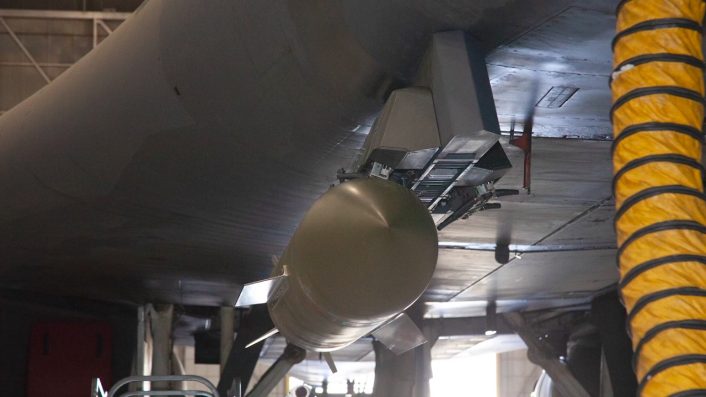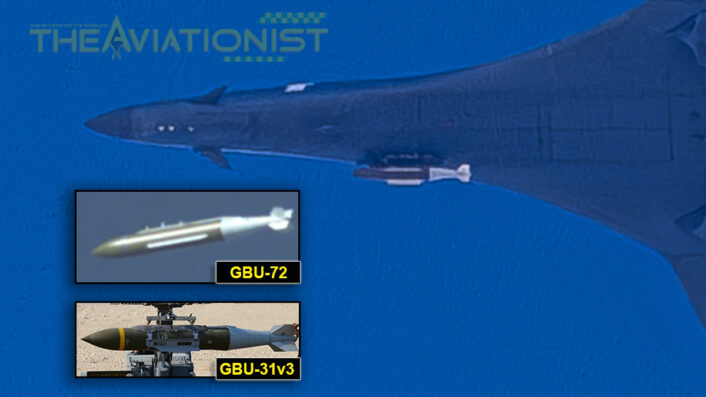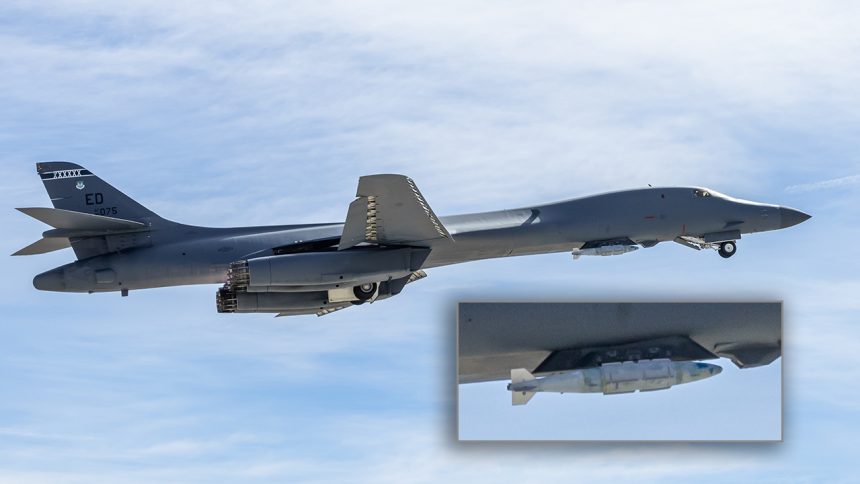The Load Adaptable Modular Pylon, installed under the B-1B bomber’s fuselage, is designed to carry a variety of weapons with fewer constraints compared to older systems.
The U.S. Air Force’s 412th Test Wing recently tested a new weapons pylon on a B-1B Lancer test aircraft with the 419th Flight Test Squadron at Edwards Air Force Base, California. Known as the Load Adaptable Modular Pylon, the new system could remove traditional weapon constraints, mentioned the service.
According to the press release, the new pylon was installed on the B-1B due to aircraft availability at Edwards, however the LAM can be modified for attachment to a variety of other aircraft if the need were to arise. LAM, designed by Boeing, is intended to carry a variety of standard and emerging weapons with seamless transition, allowing for maximum agility while also strengthening weapon test infrastructure.
“The B-1 LAM pylon is going to be used to allow us to carry a variety of different weapons and different weapons configurations on the external pylons of the B-1,” said Lt. Col. Scott Pontzer, 419th Flight Test Squadron Commander. “That will enable weapon delivery and testing in a variety of different configurations and to include new different weapon release profiles.”

The LAM pylon
The new Load Adaptable Modular (LAM) pylon was developed by Boeing with its own funds, before proposing it to the Air Force. The company found that the service could need a pylon to test newer and heavier weapons, but “at the time didn’t have the funding for it or the requirement for it, and so we stepped in,” said Jennifer Wong, Boeing’s director of bomber programs.
When the existence of the pod was unveiled in 2023, Boeing already built four of the pylons. The service then granted the company some congressional add-on funds for hypersonic systems and put it into testing at Edwards AFB.
Boeing’s idea was to shift hypersonic weapons’ testing from the B-52 to the B-1 using the new pilon, while increasing by 50% the BONE’s (from “B-One”, as the aircraft is unofficially nicknamed) payload. In fact, each pylon is shown with attachment points for two weapons.

The LAM pylon was designed to be rapidly reconfigurable to carry a variety of different new and existing weapons, thanks to adjustable mounts and attach points. The pylon can be easily reconfigured on the flightline, simplifying the work of the weapon loaders and the logistics.
According to Wong, the pylon underwent ground testing in May 2023, with captive-carry tests expected later that summer. Part of the ground testing was shown in the video released by the Air Force to announce the demonstration. Interestingly, the video appears to show also a GBU-72/B Advanced 5K Penetrator, first fully assembled in still shot and later without the strakes/fins installed during a ground drop test.
As we reported in June here at The Aviationist, a B-1B was spotted carrying for the first time the new 5,000 pound “Bunker Buster” flying over the Mojave Desert. While the images do not allow for a precise identification, it is possible that the bomber was employing the new LAM pylon to carry the GBU-72.
This could be somewhat confirmed by the words of Maj. Bryan Balkenbush, B-1B test pilot, as he mentioned the ability of the pylon to carry a 5,000 lb weapon. “This thing is a pretty big mass, the pylon itself weighs over 1,000 pounds and you’re putting a 5,000 pounds weapon, we’re talking 6,000-ish pounds on the outside of the fuselage in front of the center of mass,” said Balkenbush while describing the possible destabilizing effect of the payload that testing needed to verify.
The B-1B’s external pylons
The LAM Pylon’s demonstration reflects once again the intention to keep investing on the B-1B bomber so it continues to stay relevant in future scenarios until its retirement. While the U.S. Air Force disclosed the intention to carry externally the JASSM and the info about the ongoing tests, details about other weapons being tested were not previously disclosed, at least until the photo of the GBU-72/B and the JDAM on the LAM pylon emerged.
The external hard points were initially thought for the B-1’s nuclear strike mission. However, the bomber mission was reviewed and the type was converted to conventional only weapons with a shift decided in 1994 and a physical conversion that took place between 2007 and 2011, with the Strategic Arms Reduction Treaty (START).
The current expanded carriage demo will make the external hard points and moveable bulkhead available again for delivering conventional weapons so that the B-1 will remain complaint with the New START Treaty. The proposed increase in capacity of means that two B-1s will be able to carry as many weapons as three bombers can carry now.
The Air Force is on the brink of transforming the B-1 bomber into an Arsenal Plane, capable of striking land targets as well as enemy ships with a barrage of anti-ship and land-attack missiles. Plans are underway to equip the aircraft with up to 36 cruise missiles, significantly enhancing its firepower to levels comparable to those of an aircraft carrier.
The initiative to maximize the B-1’s missile-carrying capacity traces back to the Arsenal Plane concept. This concept, aimed to maximize the use of large aircraft by loading them with a multitude of missiles, has also brought to the development of Rapid Dragon, for palletized missile delivery.
We don’t know if the LAM pylon is a part of this concept, however the pylon’s ability to increase the B-1B’s weapons payload by 50% could make it useful. With the ability to install six LAM pylons, the BONE could load 12 weapons externally, in addition to 24 in its internal weapon bays.









